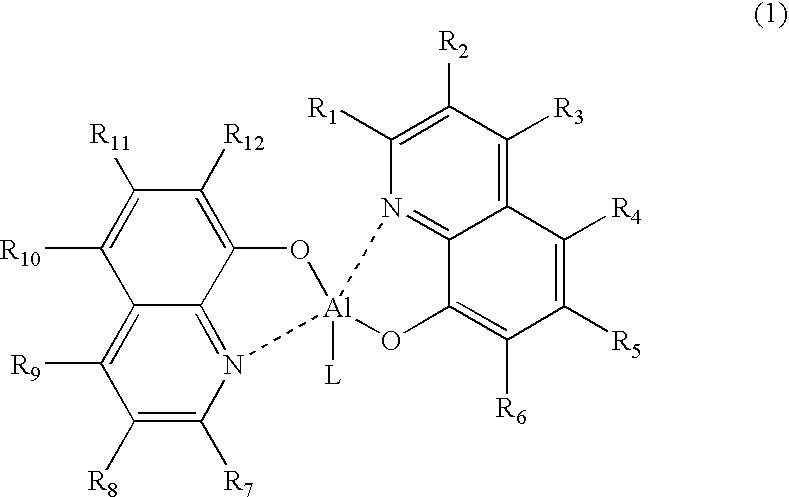Organometallic complex for organic light-emitting layer and organic light-emitting diode using the same
a technology complexes, which is applied in the direction of organic chemistry, discharge tube luminescnet screens, natural mineral layered products, etc., can solve the problems of limited viewing angle, limited application of organic light-emitting diodes, and inability to use backlight, etc., to achieve long life and high efficiency
- Summary
- Abstract
- Description
- Claims
- Application Information
AI Technical Summary
Benefits of technology
Problems solved by technology
Method used
Image
Examples
example 1
1-(1): Synthesis of 2-bromo-6-ethoxynaphthalene
[0043] 6-Bromo-2-naphthol (25 g), water (250 ml) and 1,4-dioxane (250 ml) were stirred in a three-neck round-bottom flask (1,000 ml) at room temperature. To the mixture was added a solution of sodium hydroxide in water (100 ml). After the crystals were completely dissolved, a dilute solution of diethyl sulfate (17.3 g) in 1,4-dioxane (100 ml) was slowly added thereto at room temperature. After the addition was finished, the resulting mixture was refluxed for 12 hours to obtain a white crystal. After completion of the reaction, ethyl acetate (EA) was added to the reaction mixture for phase separation. The obtained organic layer was collected, washed once with water, and concentrated under a reduced pressure to remove the solvent and obtain a crystal. The crystal was mixed with a small amount of methanol, stirred for 10 minutes, and filtered to yield 9 g of 2-bromo-6-ethoxynaphthalene.
1-(2): Synthesis of 2-phenyl-6-ethoxynaphthalene
[00...
example 2
2-(1): Synthesis of 1-methoxy-4-bromonaphthalene
[0048] 1-Methoxynaphthalene (3.5 g) and acetonitrile (350 ml) were stirred in a 500 ml round-bottom flask. To the mixture was added N-bromosuccinic acid (3.5 g) in three divided portions. The resulting mixture was allowed to react at room temperature for 10 hours. After completion of the reaction, the reaction mixture was concentrated under a reduced pressure to remove the solvent and purified by column chromatography using hexane. The hexane was concentrated to yield 4.4 g of the title compound as a gel-liquid phase.
2-(2): Synthesis of 1-methoxy-4-phenylnaphthalene
[0049] 1-Methoxy-4-bromonaphthalene (4.4 g), phenylboronic acid (3.4 g), potassium carbonate (7.7 g), water (50 ml), toluene (200 ml) and tetrahydrofuran (100 ml) were stirred in a 500 ml round-bottom flask. To the mixture was added 0.2 g of tetrakis(triphenylphosphine)palladium (0) under a nitrogen atmosphere. The resulting mixture was stirred for 24 hours while the temp...
example 3
3-(1): Synthesis of 1-methoxy-4-(2-naphthyl)-naphthalene
[0053] 1-Methoxy-4-bromo-naphthalene (10 g), 2-naphthaleneboronic acid (8.7 g), potassium carbonate (17.5 g), water (100 ml) and toluene (300 ml) were stirred in a 500 ml round-bottom flask. To the mixture was added 1 g of tetrakis(triphenylphosphine)palladium (0) under a nitrogen atmosphere. The resulting mixture was allowed to react with stirring for 24 hours while the temperature was raised to 90° C. After completion of the reaction, toluene was added to the reaction mixture for phase separation. The toluene layer was collected, concentrated under a reduced pressure to remove the solvent, and purified by column chromatography using MC. The MC extract was concentrated, mixed with a small amount of methanol, and filtered to yield of 10.1 g of 1-methoxy-4-(2-naphthyl)-naphthalene.
3-(2): Synthesis of 4-(2-naphthyl)-naphthol
[0054] 1-Methoxy-4-(2-naphthyl)-naphthalene (10.1 g), 48% hydrobromic acid (200 ml) and acetic acid (500...
PUM
| Property | Measurement | Unit |
|---|---|---|
| internal quantum efficiency | aaaaa | aaaaa |
| ionization potential energy | aaaaa | aaaaa |
| temperature | aaaaa | aaaaa |
Abstract
Description
Claims
Application Information
 Login to View More
Login to View More - R&D
- Intellectual Property
- Life Sciences
- Materials
- Tech Scout
- Unparalleled Data Quality
- Higher Quality Content
- 60% Fewer Hallucinations
Browse by: Latest US Patents, China's latest patents, Technical Efficacy Thesaurus, Application Domain, Technology Topic, Popular Technical Reports.
© 2025 PatSnap. All rights reserved.Legal|Privacy policy|Modern Slavery Act Transparency Statement|Sitemap|About US| Contact US: help@patsnap.com



